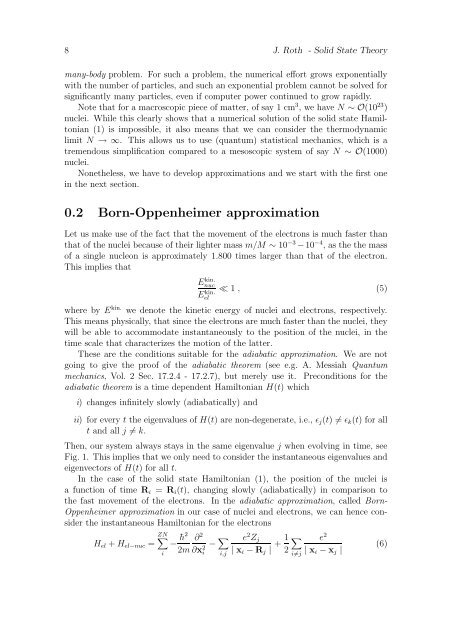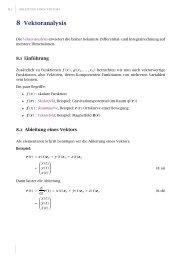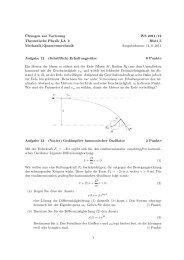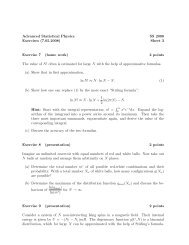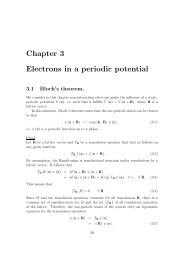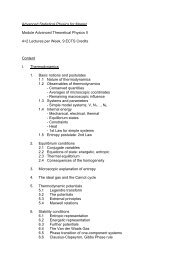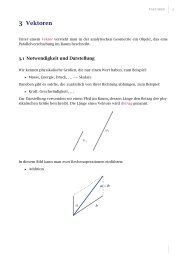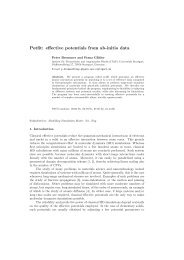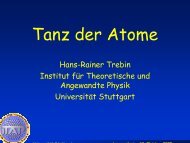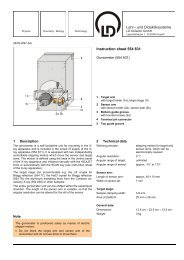Solid State Theory - Institut für Theoretische und Angewandte Physik ...
Solid State Theory - Institut für Theoretische und Angewandte Physik ...
Solid State Theory - Institut für Theoretische und Angewandte Physik ...
Create successful ePaper yourself
Turn your PDF publications into a flip-book with our unique Google optimized e-Paper software.
8 J. Roth - <strong>Solid</strong> <strong>State</strong> <strong>Theory</strong>many-body problem. For such a problem, the numerical effort grows exponentiallywith the number of particles, and such an exponential problem cannot be solved forsignificantly many particles, even if computer power continued to grow rapidly.Note that for a macroscopic piece of matter, of say 1 cm 3 , we have N ∼ O(10 23 )nuclei. While this clearly shows that a numerical solution of the solid state Hamiltonian(1) is impossible, it also means that we can consider the thermodynamiclimit N → ∞. This allows us to use (quantum) statistical mechanics, which is atremendous simplification compared to a mesoscopic system of say N ∼ O(1000)nuclei.Nonetheless, we have to develop approximations and we start with the first onein the next section.0.2 Born-Oppenheimer approximationLet us make use of the fact that the movement of the electrons is much faster thanthat of the nuclei because of their lighter mass m/M ∼ 10 −3 −10 −4 , as the the massof a single nucleon is approximately 1.800 times larger than that of the electron.This implies thatE kin.nucE kin.el≪ 1 , (5)where by E kin. we denote the kinetic energy of nuclei and electrons, respectively.This means physically, that since the electrons are much faster than the nuclei, theywill be able to accommodate instantaneously to the position of the nuclei, in thetime scale that characterizes the motion of the latter.These are the conditions suitable for the adiabatic approximation. We are notgoing to give the proof of the adiabatic theorem (see e.g. A. Messiah Quantummechanics, Vol. 2 Sec. 17.2.4 - 17.2.7), but merely use it. Preconditions for theadiabatic theorem is a time dependent Hamiltonian H(t) whichi) changes infinitely slowly (adiabatically) andii) for every t the eigenvalues of H(t) are non-degenerate, i.e., ǫ j (t) ≠ ǫ k (t) for allt and all j ≠ k.Then, our system always stays in the same eigenvalue j when evolving in time, seeFig. 1. This implies that we only need to consider the instantaneous eigenvalues andeigenvectors of H(t) for all t.In the case of the solid state Hamiltonian (1), the position of the nuclei isa function of time R i = R i (t), changing slowly (adiabatically) in comparison tothe fast movement of the electrons. In the adiabatic approximation, called Born-Oppenheimer approximation in our case of nuclei and electrons, we can hence considerthe instantaneous Hamiltonian for the electronsH el + H el−nuc =ZN∑i− ¯h22m∂ 2∂x 2 i− ∑ i,je 2 Z j| x i − R j | + 1 ∑ e 22i≠j| x i − x j |(6)


